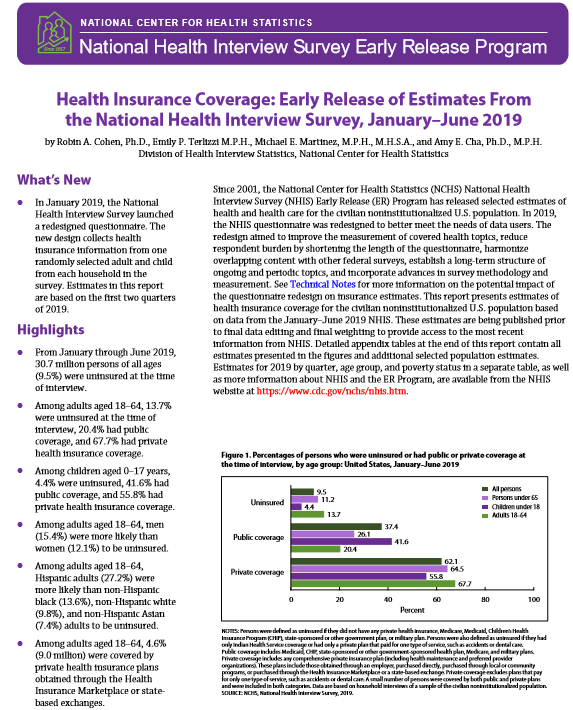Health Insurance Coverage: Early Release of Estimates From the National Health Interview Survey, January–June 2019
Posted on by Questions for Robin Cohen, Health Statistician and Lead Author of “Health Insurance Coverage: Early Release of Estimates From the National Health Interview Survey, January–June 2019.”
Questions for Robin Cohen, Health Statistician and Lead Author of “Health Insurance Coverage: Early Release of Estimates From the National Health Interview Survey, January–June 2019.”
Has the percentage of people without health insurance changed much in recent years?
RC: This most recent release from the National Health Interview Survey (NHIS) includes estimates for January through June 2019. In 2019, the NHIS questionnaire was redesigned to better meet the needs of data users. Due to changes in weighting and design methodology, direct comparisons between estimates for 2019 and earlier years should be made with caution, as the impact of these changes has not been fully evaluated at this time. A working paper entitled, “Preliminary Evaluation of the Impact of the 2019 National Health Interview Survey Questionnaire Redesign and Weighting Adjustments on Early Release Program Estimates” discusses both these issues in greater detail.
Q: Why did NCHS redesign the NHIS?
RC: In 2019, the NHIS questionnaire was redesigned to better meet the needs of data users. The redesign aimed to improve measurement of covered health topics, reduce respondent burden by shortening the length of the questionnaire, harmonize overlapping content with other federal surveys, establish a long-term structure of ongoing and periodic topics and incorporate advances in survey methodology and measurement.
Q: Has the NHIS ever been redesigned before?
RC: The NHIS has undergone several questionnaire redesigns since its inception in 1957. The last major questionnaire redesign occurred in 1997.
Q: How was the health insurance data strengthened by this redesign?
RC: The flow and content of the health insurance questions in the redesign are similar to those from 1997-2018. The main difference is that instead of a family respondent providing health insurance information for all family members as a proxy, health insurance is now asked directly of the sample adult and the parent or guardian of the sample child.
Q: Do we have a sense of how COVID-19 has impacted health insurance coverage in the U.S.?
RC: The estimates from this report are based on data collected from January through June 2019. This is prior to the COVID-19 pandemic. There are some estimates of health insurance coverage during the COVID-19 pandemic available from the Household Pulse Survey (https://www.cdc.gov/nchs/covid19/pulse/health-insurance-coverage.htm). The Household Pulse Survey is a 20-minute survey on how the COVID-19 pandemic may impact households across the country. However, these estimates of health insurance coverage may not be comparable with those using NHIS data.
Q: When will NHIS have data on the impact of COVID-19 on health insurance coverage?
RC: Data collection from the 2020 NHIS is ongoing, and the early release of estimates from the 2020 NHIS has not been determined.
Q: Is the uninsured # for kids higher than previously reported?
RC: This most recent release from the National Health Interview Survey (NHIS) includes estimates for January through June 2019. In 2019, the NHIS questionnaire was redesigned to better meet the needs of data users. Due to changes in weighting and design methodology, direct comparisons between estimates for 2019 and earlier years should be made with caution, as the impact of these changes has not been fully evaluated at this time.
Q: Anything else of note in your report that you’d like to mention?
RC: In January 2019, the National Health Interview Survey launched a redesigned questionnaire. The new design collects health insurance information from one randomly selected adult and child from each household in the survey. Estimates in this report are based on the first two quarters of 2019.
Posted on by

